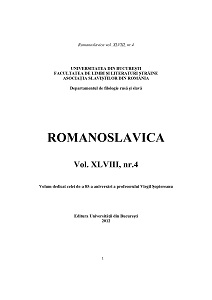Východiská a kontexty Slovenskej moderny
Origins and contexts of Slovak modernity
Author(s): Dana HučkováSubject(s): Recent History (1900 till today), Comparative Study of Literature, Slovak Literature, Theory of Literature, Sociology of Literature
Published by: Editura Universităţii din Bucureşti
Keywords: Literary Modernism; Slovak literature; 20th century; Slovak Modernism; literary contexts; cultural resonances;
Summary/Abstract: In the literary output of the Slovak Modernist authors the period aesthetic universalities of the artistic Modernism, roughly dated 1890-1914, were connected with peculiarities of regional, national literature, traditionally defined by, as well as perceived through the national concept. As a result of predominance of the national aspect in the previous perception of literature, the Slovak cultural environment may have experienced restructuring of values of the period topics, but with a clear subscription to the autonomous character of the aesthetic function of literature and individual creative gesture. Slovak Modernism evinces identifiable thematic resonances and contextual proximities with the contemporary European ideological currents and trends. The authors, Ivan Krasko, Janko Jesenský, Ivan Gall, František Votruba, Ľudmila Groeblová, Vladimír Roy, Vladimír Hurban-Svetozárov, Martin Rázus, Samo Cambel-Kosorkin, Juraj Slávik-Neresnický, abandoned the social-ideological take on literature and undertook to emphasize the moment of intimacy and sensitivity of production, which was perceived as an individual self-expression, escape from solitude, the act of confession, and the outcome of a mood and artistic rendition of a unique moment. The starting point was the feeling of sensual deprivation, failure, disappointment, loss, intellectual distress, and crisis. The perception of crises became manifest in vacillation between of activity and inertia, harmony and chaos. The revived Romantic poetics with impressionist overtones began to appear sporadically around 1900 and after 1905 (the year Janko Jesenský‘s book of poetry, Verše / Verses/ was published), it became widespread, with culmination between 1908-1912. At that point, the revived Romanticism and Impressionism took a noticeably Symbolist turn. The motifs of decadent stylization are relatively rare. The inclination of late Symbolism towards the grotesque (grotesque-carnival) in the Slovak context is suggested by the repeated ironic twist of the texts and perception of life as a farce, carnival or fancy dress ball.
Journal: Romanoslavica
- Issue Year: XLVIII/2012
- Issue No: 4
- Page Range: 195-209
- Page Count: 15
- Language: Slovak

